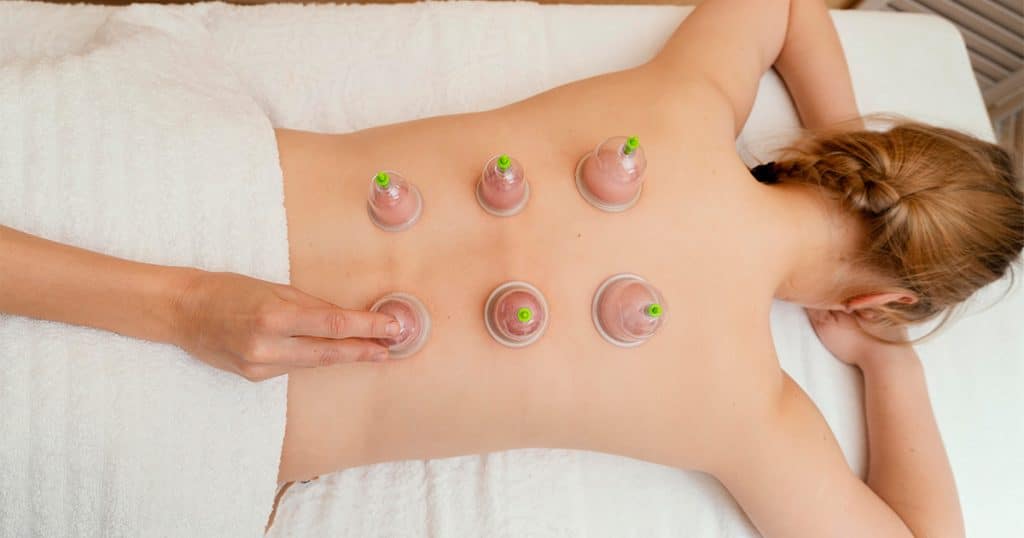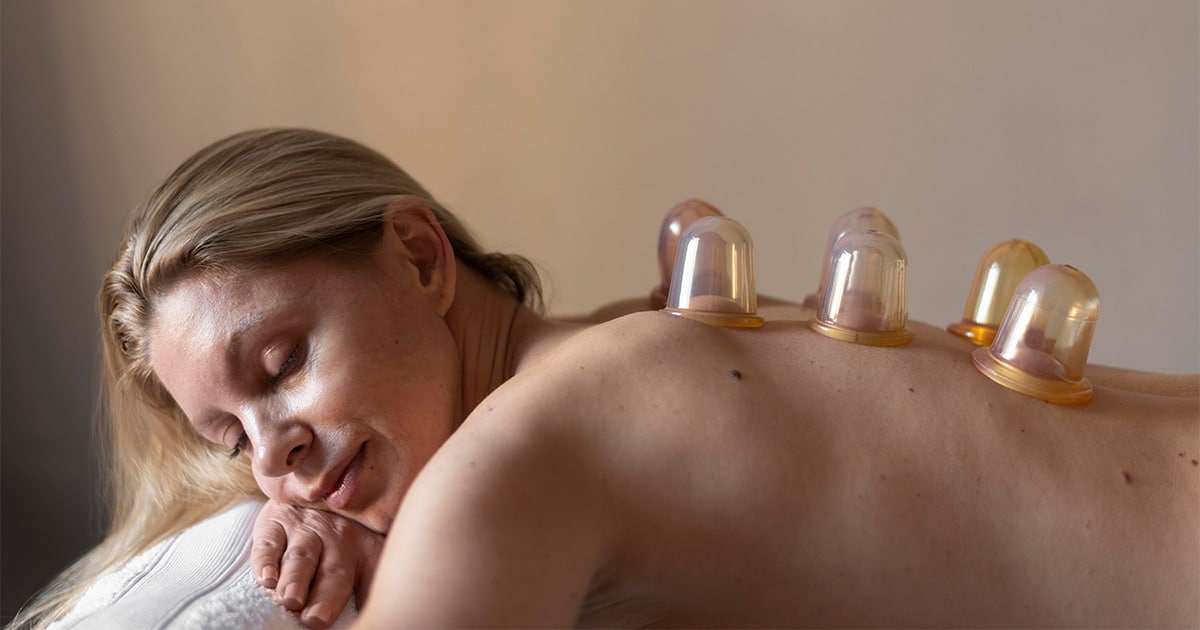Restore Wellness Studio offers an excellent dry cupping therapy experience in Dallas, TX, which helps improve blood flow and cell repair in your body.
What is Dry Cupping Therapy?
Dry Cupping Therapy is one of the oldest and most efficient ways to remove toxins from body tissue and organs is through cupping therapy.
Other names for it include horn therapy, suction cupping, and hijama cupping. In order to create suction, the therapist uses specific cups on the skin. This increases blood flow to the damaged area by forcing the tissue beneath the cup to be pulled up and expanded.
Increased blood flow beneath the cups pulls contaminants and poisons out of the surrounding tissues and organs and up to the surface, where they can be eliminated.
History of Cupping Therapy
One of the earliest known treatments for many illnesses is cupping. Animal horns, bamboo, ceramic, glass, metal, and plastic have all been used in this practice found in Ancient Egyptian, Chinese, Unani, Korean, Tibetan, and Latin American cultures, all of which have served to support the body’s ability to heal itself. Cupping techniques and styles have frequently reflected the geographic locations they were practiced in throughout history, as well as utilizing a region’s local materials.
The first mention of cupping therapy was made in North Africa on Eber’s papyrus (1550 BCE), where a cup is the Egyptian sign for a doctor. Ge Hong (281-341 CE) recounts the usage of animal horns as a method of removing bodily fluids during the Jin dynasty in Asia. Additionally, it was well-liked throughout the Greek Bronze Age, when bronze cups were used.
Cupping and other therapies of a similar nature in Chinese medicine adhere to the Daoist holistic model. The philosophy of holism holds that systems and their properties should be viewed as a whole rather than as a sum of their components. Daoists argued that no individual being or human could exist unless they were viewed in relation to nature, as an extension of the world, and as such, were affected by both external phenomena like the seasons and climate as well as internal states like emotional stress. This idea holds that illness results from environmental factors, emotional factors, and/or trauma that cause an imbalance in the body.
Chinese traditional medicine practices are regarded as “alternative” by the established medical systems despite being used for centuries in many different cultures and nations around the world because Chinese medicinal researchers concentrate on observable principles of balance examined in living bodies.
“The promotion or use of practices which are unproven, disproven, impossible to prove, or extremely detrimental in comparison to their effect” is the definition of alternative medicine. Unfortunately, only an epistemological perspective has been used to understand medicine, especially Western allopathic medicine. A theory of knowing that distinguishes between justified belief and opinion is established using this framework. As a result, evidence-based medicine has become the standard practice, heavily favoring anatomical dissection over any other type of inference or approach when coming up with a diagnosis and/or course of action.
Modern cupping, which has its roots in western cupping, affects the physiology of the myofascial tissue by using cups made of plastic, silicon, or glass that are vacuum-sealed.
Various categories of cupping:
Technically:
- Drought cupping
- Oil cupping/Sliding cupping: This technique involves applying massage oils, attaching cups to the body, and sliding the cups across a target location.
- Flash cupping or empty cupping: This technique uses multiple cups applied quickly and repeatedly with little retention. It eases local congestion and promotes movement across a larger area.
Technique for Suction
- Manual Suction: To manage the suction, use a manual pump made of plastic cups.
Fireplace cupping
- Horn cupping / Raktamokashan by shrung; Moxa cupping
- Pulsatile cupping: a mechanical device that uses a pump to create a pulsatile suction
- Additional Therapy Cupping: Hot needle cupping and acupuncture cupping
- Other: Solar plexus cupping; Deep tissue cupping and drainage;

Indications
Both healthy individuals (for anti-aging and rejuvenation purposes) and those with illnesses can benefit from cupping therapy. Headaches, neck discomfort, knee pain, and lower back pain are examples of localized conditions that respond well to cupping therapy. Hypertension, rheumatoid arthritis, diabetes mellitus, mental disorders, heart disease, hypertension, and infections are a few systemic diseases that have benefited from cupping therapy. It can be used to treat allergy disorders, skin illnesses, respiratory, musculoskeletal, digestive, and reproductive issues.
Benefits
- Cupping reduces inflammation and pain.
- Enhances circulation.
- Used for deep tissue massage, relaxation, and wellbeing.
- It is a low-cost, non-invasive, and safe procedure.
- The renewal of bodily organs.
- Strengthens the immune system and speeds up the healing process.
- Used to treat gynecological issues, rheumatic diseases, including as arthritis and fibromyalgia, and blood disorders like anemia and hemophilia.
- Eczema and acne are two skin conditions
- Blood pressure problems
- Headaches, worry, and depression
- Spider veins
Effects
- Skin: Enhanced metabolism in skin tissue, improved perspiration and sebaceous gland activity, improved skin resilience, and improved healing
- Muscles: Promotes lymphatic drainage and blood flow.
- Joints: Increased blood flow and synovial fluid secretion.
- Digestive system: Improved digestion and excretion, increased peristalsis, and the release of digestive juices.
- Blood: Better RBC and WBC performance and enhanced blood circulation.
- Nervous System: Activates skin’s sensory nerves and enhances ANS.
A low-risk therapy is cupping. Usually, the adverse effects happen during or right after your therapy. Sweating, slight nausea, or feeling lightheaded may occur.
Following treatment, the skin around the cup’s rim may itch and develop circular marks. If the practitioner uses the proper techniques for cleaning skin and preventing infection before and after the session, infection risk after receiving cupping therapy can be reduced.
Who Is Cupping Therapy Suitable For?
Practice of cupping is a simple, extremely safe therapy. Since it is absolutely uncontrolled, anyone can engage in it. It must abide by the restrictions and laws listed within the practice’s scope if it is carried out within a regulated health practice. The therapy cannot be started until a sufficient response is found if the therapist/practitioner is not a member of a college or association, or if they are unsure. Precautions must be made if a therapist or practitioner has not received training in a modality or is not undergoing additional training to treat specific conditions.
Technique / Application of Cupping in Physiotherapy
The skin rises when a physiotherapist uses a rubber pump to generate a vacuum. The massage effect is produced by the blood vessels expanding.
The locations are chosen based on the condition being treated. The places with lots of muscles are frequently where the cups are positioned. The most frequent areas for application are the back, followed by the chest, abdomen, buttocks, and legs. Cupping may also be used to treat other areas, such the face. Studies have shown that cups should not be left on the skin for longer than 5 to 10 minutes. In 1 to 10 days, the cupping-related scars vanish.
Significance
- Cupping can provide pain relief and help reduce the symptoms of many common illnesses of the bones and muscles.
- It increases blood flow to uncomfortable places in muscles, delivers critical nutrients, and promotes healing.
- Cupping Therapy can be highly calming and assist to relieve muscular limitations, scars and adhesions, to minimize swelling, and to increase range of motion. It achieves this by stimulating tiny nerves inside muscles so that they release pain-killing chemicals.
Procedures before and after
- The patient should receive enough counseling regarding the procedure and any markings or scars that may result from it.
- Obtain consent if necessary.
- Prior to cupping, the surface should be cleaned or disinfected.
- Look for wounds, cracks, and a localized increase in temperature.
- Look for skin sensitivity.
- To avoid any potential infection, apply moisturizer or an antiseptic cream after the surgery.
Contact Restore Wellness Studio Today
Call Restore Wellness Studio at (469) 943-5883 or schedule an appointment today.

